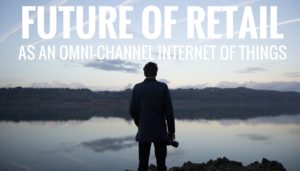Future of Retail as an Omni-Channel ‘Internet of Things’ | Jeff Ashcroft | LinkedIn
The future always comes faster than we think.
Even more so in the evolving world of fast retailing where websites are now merging with bricks and mortar stores to create what last April I dubbed The Endless Store.
How will retailers manage in stores without boundaries inhabited 24/7/365 by almost 8 Billion shoppers armed with mobile computing and payment devices?
Not easily, and certainly this new reality is as terrifying as it is awe inspiring to those with true merchant blood coursing through their veins.
Welcome to the world of Matrix Commerce aka Matrix Retail where retailers will have to monitor, manage, optimize and move more information and products faster than ever before.
The question is how will they be able do this quickly, accurately and effectively given the growing scale and complexity of evolving digital retail business?
When it comes to managing the reams of associated information and making the multitudes of rapid decisions needed to manage Matrix Commerce, new technology will be required to keep up. The human managers and masters of these retail supply chains, stores and online spaces will likely need to augment their capabilities through the use of cognitive technologies.
When it comes to products, many years and billions of barcodes have been printed to try and keep track of retail store inventories. And frankly other than improving checkout accuracy and speed this now somewhat antiquated technology still relies on people to maintain inventory accuracy at stores which just doesn’t work.
And even where the rare store can make it work, this method is not fast enough to keep up with the instantaneous requirement to power omni-channel retail.
The time for people to try and keep track of products in stores has passed, it’s over and never really worked, it’s now time for the products to keep track of themselves.
All products now need smart labels and smart tags to keep track of them at the item, pack, case and pallet level from manufacturing through distribution, to stores and then the ultimate delivery to, and returns by consumers. I would use the term RFID to describe these tags, but for some reason for several years RFID has been treated as the bastard child of the retail business, but hopefully not for much longer.
The tide is starting to shift towards the use of smart labels and smart tags as this example from lululemon‘s results quoted from RFID Journal demonstrates.
Global athletic apparel company lululemon reports that it has boosted its in-store revenue by deploying a radio frequency identification system at all of its stores to track its products’ movements as they arrive at stores, are placed on display on the sales floor and are sold. The system has increased the company’s inventory accuracy to 98 percent, says Jonathan Aitken, lululemon’s RFID program director, which is one reason that the company’s revenue is up, since its stores know what goods are available in the back room to be restocked on the sales floor and purchased. The company’s ability to access RFID-based inventory data and choose to sell goods online or in store accounted for 8 percent of e-commerce revenue for the quarter, said Stuart Haselden, lululemon’s CFO, during the firm’s third-quarter investor call in December 2015
Not only can this technology be utilized for inventory control and tracking purposes, it also can enhance the sales process and sharing of product information in store to assist in purchasing decisions.
This Store of the Future video from Electric Runway features a pop up store put together by withme, featuring brands TOMS shoes and Raven & Lily apparel.
Online and bricks & mortar retailers who continue to operate in status quo mode will not be able to keep up with the customer experience demands of the mobile connected consumer.
The world of retail is now omni-channel and shoppers live in a fast moving connected world where Endless Store shopping environments will be the norm.
Products will soon utilize smart labels and tags to keep track of themselves, communicating with both systems and consumers to manifest the emerging future of retail as an omni-channel internet of things.
Jeff Ashcroft
